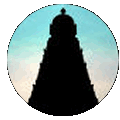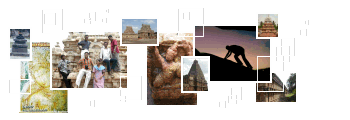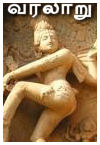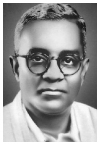 |
 |
 |
http://www.varalaaru.com A Monthly Web Magazine for South Asian History [187 Issues] [1839 Articles] |
 |
 |
 |
http://www.varalaaru.com A Monthly Web Magazine for South Asian History [187 Issues] [1839 Articles] |
|
Issue No. 10

இதழ் 10 [ ஏப்ரல் 15 - மே 14, 2005 ] 
இந்த இதழில்.. In this Issue.. 
|
Society was born when people started to live in groups. It was a hunting society to begin with and the discovery of agriculture has completely changed its outlook and ideals. Scholars from all over the world have worked on their religious habits and contributed the concept of Mother goddess. Extensive evidences are gathered to prove that the worship of Mother goddess was one of their dominant practices. Difference of opinion prevails among the scholars regarding the cause by which woman was elevated to the level of goddess. One group contributes the discovery of agriculture by women as the cause of their raise. They refer to a seal collected from the Harappan site and a terracotta relief of early Gupta period in support of their arguments. On the Harappan seal, a nude female figure is depicted upside down with legs apart and with a plant issuing from her womb. The terracotta relief of the early Gupta age depicts the goddess in the same posture but with a lotus issuing from her neck instead of from her womb. Both the seal and the terracotta relief express the capacity of a woman to give birth to new life and this raised her status in the society which had no idea of the physiology behind pregnancy and childbirth. The authors of this article strongly believe that this capacity of creating new life had raised the woman to the level of Mother goddess and not the discovery of agriculture. Numerous terracotta figurines identifiable with Mother goddess were discovered from the Harappan and the Indus sites which were once the cradle of Tamil civilization. It may be safely surmised that the worship of mother goddess was the beginning of Amman worship. The earliest reference of Amman worship is available as ‘Kotravai Nilai” in Tolkappiyam, an ancient grammatical work of the Tamils. Kotravai nilai may be defined as a form of worship in which the glory of Kotravai as a war goddess was eulogized and her blessings towards victory was requested by the soldiers before setting forth for any war. The iconological details of Kotravai are not found either in Tolkappiyam or in the Sangam anthologies but for Kalittokai, Paripadal, and Thirumurukatruppadai that are identified as later works. Kotravai, worshipped by the Sangam Warriors as a war deity, is celebrated as “vetrivel por kotravai” (வெற்றிவேல் போர்க் கொற்றவை”) by Thirumurukatruppadai. Kalittokai calls her as kotri and says that she lived in the forest in the midst of devils. “kotravai kolam kondor pen” (“கொற்றவைகோலம் கொண்டோர் பெண்”), a line from Paripadal confirms that there was a definite iconological format for the deity. Thirumurukatruppadai mentions Murugan as the son of Kotravai and celebrates him as “Kotravai Chiruva” and “palaiyol kuzhavi”. The word palaiyol confirms the antiquity of Kotravai. Perumpanatruppadai, one of the ancient Sangam anthologies, mentions Muruga as, “sey” and says that he was born to Kotravai. It agrees with Kalittokai by saying that Kotravai was surrounded by spirits. A collective analysis of all these data reveal that Kotravai was worshipped as a war goddess with her abode in the forest and she was under the control of evil spirits. By this it may be concluded that the mentioning of “onku pukazh kanamar chelvi” by Agananuru refers to only Kotravai. Manimekalai, supports this view by exposing a shrine that existed in the forest for “kadamar chelvi”. Kuruntokai, another ancient Sangam classic says that Kotravai was worshipped even by the women fold of the mountain region. Murugan was accepted as the son o fKotravai in the Sangam period itself. Kalittokai, positively a post Sangam classic, introduces him as the son of Siva. Even though said by two different literary works of two different times it may be understood that it was a known fact even in the Sangam period that Siva, Kotravai and Murugan formed a family. Though there is no direct reference to Kotravai and Siva as husband and wife, the scattered data gathered from different works confirms the concept of family that existed between the three gods. Maybe this formed the basis for the introduction of Somaskanda, a Pallava icon. Ananku, varai aria makalir, churara makalir, chuvar pavai and kadal kelu chelvi were some of the feminine demi-gods that were worshipped in the Sangam period apart from the primary female deity Kotravai. Uma is introduced for the first time by Kalittokai, Paripadal and Thirumurukatruppadai, all considered to be post Sangam classics. All the three works identify her as the consort of Siva. As per Kalittokai Uma was seated with Siva in Kailas. Siva is described as the god who used the mount Himalayas as a bow, received the Ganges and over thrown the ten-headed Asura who attempted to dislodge Kailas. All the three attributes showered on Siva by Kalittokai were transformed into sculptures by the Pallava craftsmen. Among them two included Uma as consort of Siva in the panel. The wedlock between Siva and Uma is mentioned in Paripadal. But it claims the birth of Muruga to the six damsels of Karthikai asterism and calls him as the son of Siva, Nilakandan. Thirumurukatruppadai which introduces the Ardhanari concept of Siva confirms this. Kalittokai, Paripadal, and Thirumurukatruppadai project Uma but mentions Kotravai also. The changes that had occurred due to the influences of Aryan mythology in the worship of Siva, Kotravai, and Muruga as a family is well recorded in these works. Uma, a newly introduces Aryan goddess, replaces Kotravai and Siva who worshipped as Mukkat Chelvan by the ancient Tamils got transformed into “Iranchadai anthanan” and “Painkan Parppan”. Thirumurukatruppadai, which mentions Muruga as the son of Kotravai in one place, refers to him as the son of Malaimakal in another place. It also adds that Muruga was born out of Karthikai damsels who swallowed the seed received from Siva. Paripadal which explains the birth of Muruga to the Karthikai damsels mentions on other occasions that he was born to Siva and Masilol. The identity of Masilol is not clear. Mixing up of two different ideologies, the Dravidian and the Aryan was perhaps the reason for all these confused recordings in the literature and this decides the date of these three literary works as post Sangam and pre Devaram. Kotravai was the only primary feminine deity of the Sangam age. Uma joined her at the fag end of this period and gained prominence. It was natural for a tribal society which fought frequently with other groups to establish dominance and peace, to have kotravai a fierce deity as their primary goddess. But once settled with agriculture and on establishing civilization by developing contacts, the society accepted Uma, a newly introduced docile goddess who played a soft role as the consort of Siva. Mythological developments superimposed Uma on the concept of Kotravai and stamped Kotravai as Durga. Though a gradual replacement was experienced at the urban level Kotravai still enjoyed the status of a primary goddess in the villages where the tribal atmosphere continued for centuries. The literary works of the post Sangam period and the sculptures and inscriptions of the Pallava period stand in line to support this observation. Chilappathikaram has recorded the relationships formed between Uma, Siva, and Kotravai, the decline in popularity Kotravai suffered in the urban area by the entrance of Uma, the continuation of the supremacy enjoyed by Kotravai at the rural belt in spite of this entry and the transformation of Kotravai into Durga. Ilangovadigal who has authored the epic is to be appreciated for the excellent documentation done, reflecting all the obvious changes that had occurred in the society influencing the Amman worship. Chilappathikaram refers to Uma only in three places and in all the three places she is mentioned in context of Ardhanari appearance. Even while mentioning the temples of Siva reference to Uma is not made. The third eye of Siva, that makes Purananuru to call him as Mukkat Chelvar, is described as nutal vizhi in Chilappathikaram. The same is attributed to Kotravai in Paripadal. Chilappathikaram also mentions this in one of its chapters. All these reveal not only the contemporary emergence of these two literatures but also exhibit the care with which the authors of those days recorded all the mythological developments that influenced the society. Elangovadigal, who mentions Uma only in three places allot one full chapter to explain the worship of Durga turned to Kotravai. Vettuva Vari, the twelfth chapter of Chilappathikaram draws a vivid picture of the events that occurred at Iai kottam, a temple for Kotravai built adjacent to the settlement of Maravas. An analysis of the poetic version provides a complete iconological description of Kotravai and as well about the conduct of her worship. She was praised by the maravas as Amari, Kumari, Gauri, Samari, Suli, and Nili. The worship was followed by a group dance in which ballads composed in praise of Kotravai were sung. The songs claimed that she, the wise of Siva shared his body in the Ardhanarisvara incarnation of him and she, the sister of Vishnu stood on the head of a buffalo. The first direct reference to Kotravai as the wife of Siva occurs only in Chilappathikaram, though her existence is recorded in Tolkappiyam, much earlier work. She is bestowed with all the attributes that belonged to Siva. For the first time she is recognized as the sister of Vishnu. It is also said that she is the guiding light of the Trimurtis and thereby establishing her supremacy over them. To be continued... Remaining part of the article will be post here itself soon. |

சிறப்பிதழ்கள் Special Issues 

புகைப்படத் தொகுப்பு Photo Gallery 
|
| (C) 2004, varalaaru.com. All articles are copyrighted to respective authors. Unauthorized reproduction of any article, image or audio/video contents published here, without the prior approval of the authors or varalaaru.com are strictly prohibited. | ||